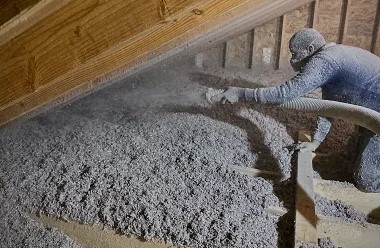Cellulose insulation is generally considered safe for use in homes and buildings. Made from recycled paper products, it is non-toxic and flame-resistant.
Cellulose insulation provides an environmentally-friendly option for insulating homes and buildings. It is made from recycled paper products and treated with non-toxic fire retardants, making it a safe and sustainable choice. This type of insulation is also mold-resistant and helps to reduce energy consumption, offering both health and environmental benefits.
Its eco-friendly nature and safety make cellulose insulation a popular choice for many homeowners and builders. This type of insulation is also known for its ability to effectively reduce noise and provide better temperature control, adding to its appeal to environmentally-conscious consumers.
Composition And Chemical Properties Of Cellulose Insulation
Cellulose insulation is considered to be safe due to its composition and chemical properties. Made from recycled paper fibers, cellulose insulation contains cellulose fiber and is treated with fire retardants for added safety. These fire retardants are usually borate-based, which are non-toxic and have been widely used in various applications.
The borate compound in cellulose insulation acts as a flame retardant, inhibiting the spread of fire. Additionally, cellulose insulation is treated with mold and pest inhibitors to prevent the growth of mold and deter insects and rodents. This makes cellulose insulation a safe and environmentally friendly choice for insulation purposes.
Its composition and chemical properties make it an effective and sustainable option that provides thermal insulation, soundproofing, and energy efficiency benefits. With its safety features and ecological advantages, cellulose insulation is a reliable and sustainable option for homeowners.
Health And Safety Considerations: Inhalation And Skin Contact
Cellulose insulation is a popular option for homeowners due to its environmentally friendly nature and excellent thermal performance. However, it is crucial to consider the potential health and safety concerns associated with this type of insulation. Inhalation is the primary concern when it comes to cellulose insulation.
Fine particles of cellulose can become airborne during installation, which may pose a risk if inhaled in large quantities. It is important to wear protective gear, such as masks, to minimize the risk of breathing in these particles. Skin contact is also a consideration, as some individuals may be sensitive or have allergic reactions to the materials used in cellulose insulation.
Taking necessary precautions, such as wearing long-sleeved shirts and gloves, can help prevent any potential skin irritation. By following these guidelines, homeowners can enjoy the benefits of cellulose insulation while ensuring their health and safety.
Fire Safety And Flame Retardants In Cellulose Insulation
Cellulose insulation is commonly used for its energy efficiency and eco-friendly properties, but many homeowners have concerns about its fire safety. Understanding the fire safety features and flame retardants in cellulose insulation can help address these concerns. Cellulose insulation is treated with flame retardants, which prevent it from igniting easily and slow down the spread of flames.
These flame retardants are typically made from non-toxic materials, such as borate or ammonium sulfate. They are applied during the manufacturing process of cellulose insulation, ensuring that the flame retardants are evenly distributed throughout the product. In case of a fire, cellulose insulation can help slow down the spread of flames by smoldering instead of burning.
It forms a protective layer that blocks the access of oxygen to the fire, effectively reducing the intensity and speed of the flames. Additionally, cellulose insulation is known for its high-density structure, which further contributes to its fire-resistant properties. Overall, when properly installed and treated, cellulose insulation is considered safe and fire-resistant.
It meets the necessary fire safety standards and can provide an excellent option for insulating homes while minimizing the risk of fire hazards.
Environmental Impact And Sustainability Of Cellulose Insulation
Cellulose insulation is widely recognized for its environmental impact and sustainability. Made from recycled paper and treated with fire-retardant chemicals, cellulose insulation is a safe and eco-friendly option for insulating homes. Its production process consumes less energy and produces fewer greenhouse gases compared to other insulation materials, making it a sustainable choice for environmentally conscious homeowners.
Additionally, cellulose insulation is biodegradable and can be recycled at the end of its useful life, further reducing its environmental footprint. With its ability to effectively regulate indoor temperatures and reduce energy consumption, cellulose insulation not only benefits the environment but also contributes to long-term energy savings for homeowners.
Regulatory Standards And Industry Certifications For Cellulose Insulation
Cellulose insulation is considered safe and environmentally friendly for residential use. It is regulated by various industry standards and certifications, ensuring its quality and safety. Regulatory bodies set guidelines for the production and installation of cellulose insulation to meet safety and performance requirements.
Industry certifications provide additional assurance of the product’s safety and compliance with industry standards. Cellulose insulation is tested for fire resistance, mold resistance, and performance to ensure its safety for homeowners. When properly installed by certified professionals, cellulose insulation provides effective thermal and sound insulation while being a safe choice for the environment and indoor air quality.
Conclusion
Cellulose insulation is a safe and environmentally friendly option for insulation. Its eco-friendly composition and ability to effectively reduce heat transfer make it a popular choice among homeowners. While it may have some minor drawbacks, such as potential moisture issues, proper installation and maintenance can mitigate any risks.
Overall, cellulose insulation offers a cost-effective and reliable solution for improving energy efficiency and comfort in homes.
